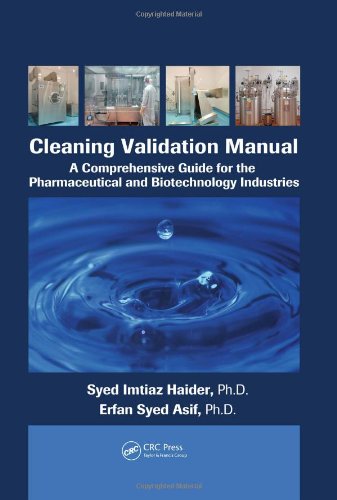

Most ebook files are in PDF format, so you can easily read them using various software such as Foxit Reader or directly on the Google Chrome browser.
Some ebook files are released by publishers in other formats such as .awz, .mobi, .epub, .fb2, etc. You may need to install specific software to read these formats on mobile/PC, such as Calibre.
Please read the tutorial at this link. https://ebooknice.com/page/post?id=faq
We offer FREE conversion to the popular formats you request; however, this may take some time. Therefore, right after payment, please email us, and we will try to provide the service as quickly as possible.
For some exceptional file formats or broken links (if any), please refrain from opening any disputes. Instead, email us first, and we will try to assist within a maximum of 6 hours.
EbookNice Team

Status:
Available0.0
0 reviews
ISBN 10: 1439826609
ISBN 13: 9781439826607
Author: Syed Imtiaz Haider, Erfan Syed Asif
During the past decades, enormous progress and enhancement of pharmaceutical manufacturing equipment and its use have been made. And while there are support documents, books, articles, and online resources available on the principles of cleaning and associated processing techniques, none of them provides a single database with convenient, ready-to-use training tools. Until now. Cleaning Validation Manual: A Comprehensive Guide for the Pharmaceutical and Biotechnology Industries elucidates how to train the man power involved in development, manufacturing, auditing, and validation of bio pharmaceuticals on a pilot scale, leading to scale-up production. With over 20 easy-to-use template protocols for cleaning validation of extensively used equipments, this book provides technical solutions to assist in fulfilling the training needs of finished pharmaceutical manufacturers. Drawing on the authors’ more than two decades of experience in the pharmaceutical and biotech industries, the text offers hands-on training based on current approaches and techniques. The book does not merely provide guidelines or thought processes, rather it gives ready-to-use formulas to develop Master Plan, SOPs, and validation protocols. It includes cleaning procedures for the most commonly used equipment in various manufacturing areas and their sampling points, using a pharmaceutical manufacturing site with both sterile and non-sterile operations as the case facility. It also provides the training guidelines on downloadable resources to enable users to amend or adopt them as necessary. Grounded in practicality, the book’s applicability and accessibility set it apart. It can be used as a guide for implementing a cleaning validation program on site without the help of external consultants, making it a resource that will not be found collecting dust on a shelf, but rather, referred to again and again.
CLV-1 How to Establish a Cleaning Validation Program
1.1 Cleaning in Finished, Biopharmaceuticals, and Bulk Chemicals
1.1.1 Cleaning Program Norms
1.1.1.1 Cleaning Methods
1.1.1.2 Equipment
1.1.1.3 Product
1.1.1.4 Facility
1.1.2 Cleaning Validation
1.1.2.1 Cleaning Validation Program
1.1.2.2 Residues and Residue Removal
1.1.2.3 Cleaning of Equipment
1.1.2.4 Cycle Development
1.1.2.5 Sampling Techniques and Analytical Methods
1.1.2.6 Limits and Acceptance Criteria
1.1.2.7 Ongoing Monitoring of Cleaning
1.1.2.8 Change Control
CLV-2 Introduction
2.1 Cleaning Validation
2.1.1 U.S. FDA Guidelines
2.1.2 Health Canada Guidelines
2.1.3 EU-GMP Guidelines
2.2 Validation Master Plan
CLV-3 Scope and Approach
CLV-4 Cleaning Validation Team Members and Responsibilities
4.1 Specific Responsibilities
4.1.1 Validation Department
4.1.2 Production
4.1.3 Packaging
4.1.4 Utilities/Calibration/HVAC
4.1.5 Quality Control
4.1.6 Quality Assurance
4.1.7 Product Development Laboratory
CLV-5 Cleaning Validation Philosophy, Strategies, and Methodology
5.1 Cleaning Validation Philosophy
5.2 Cleaning Validation Strategies
5.2.1 General
5.2.2 Specific
5.3 New Products, Equipment, and Processes
5.4 Cleaning Validation Methodology
CLV-6 Planning Phase
6.1 Prevalidation Requirements
6.1.1 Equipment
6.1.2 Cleaning Procedures
6.1.3 Personnel Training
6.2 Worst-Case Product Selection Matrix
6.3 Analytical Development
6.4 Recovery
6.5 Protocol Development
CLV-7 Execution Phase
7.1 Visual Examination
7.1.1 Sampling
7.1.2 Swab Sampling
7.1.3 Rinse Sampling
CLV-8 Analytical Testing and Reporting Phase
8.1 Acceptance Criteria
8.1.1 Limits Determination
8.1.2 Microbial Burden
8.1.3 Analytical Results Reporting
8.1.4 Incident Investigation
8.1.5 Reports
8.1.6 Monitoring
8.1.7 Change Control/Revalidation
CLV-9 Equipment Description
9.1 Solid Dosage Manufacturing
9.1.1 Equipment Description
9.2 Sterile
9.2.1 Equipment Description (Injectables)
9.3 Liquid Manufacturing
9.3.1 Equipment Description (Soft Product)
9.4 Filling Lines
9.4.1 Equipment Description (Soft Product)
CLV-10 Facility Description
10.1 Solid Dosage Manufacturing
10.1.1 Facility Description
CLV-11 Utilities Description: DIW, WFI, Steam, and Compressed Air
11.1 Utilities Description
11.1.1 Water System
11.1.2 WFI System
11.1.3 Purified Water System
11.1.4 Process Chilled Water System
11.1.5 Steam System
11.1.6 Compressed Air
11.1.7 Compressed Air (Solid and Liquid Products)
11.1.8 Nitrogen System
CLV-12 Utilities Monitoring and Microbiological Control
CLV-13 Equipment Cleaning Materials/Detergent Description
13.1 Solid Dosage Plant
13.2 Sterile Plant
13.3 Antibiotic Plant
13.4 Liquid Dosage Plant
CLV-14 Microbiological Cleaning of Equipment Surface
CLV-15 Solubility of Active Materials in Water
CLV-16 Toxicity of Active Materials
CLV-17 Cleaning Validation Products Grouping Matrix (Tablets, Capsules, and PPS)
17.1 Product Grouping Matrix (Solid Dosage)
17.1.1 Tablets
17.2 Product Grouping Matrix (Capsules)
17.3 Product Grouping Matrix (Granules)
CLV-18 Product/Equipment Train Matrix (Tab-Cap-PPS)
18.1 Products/Equipment Train (Tablets, Capsules, and PPS)
18.1.1 Wet Granulation Uncoated Tablets
18.1.2 Wet Granulation Coated Tablets
18.1.3 Dry Granulation Uncoated Tablets
18.1.4 Dry Granulation Coated Tablets
18.1.5 Sugar-Coated Tablets
18.2 Product/Equipment Train (Capsules)
18.3 Product/Equipment Train (Granules)
CLV-19 Worst-Case Products (Tablets, Capsules, and PPS) Matrix
19.1 Worst-Case Products (Tablets)
19.1.1 For Coating Machines Only
19.1.2 Sugar-Coated Products (for Conventional Coating Pans)
19.2 Worst-Case Products (Capsules)
19.2.1 For Encapsulator A
19.2.2 For Encapsulator B
19.3 Worst-Case Products (Granules)
CLV-20 Validation with Corresponding Cleaning Procedures
20.1 Protocols for Tablets Manufacturing Equipment
CLV-20.1 Cleaning Validation Protocol for Fluid Bed Dryer
20.1.1 Objective
20.1.2 Scope
20.1.3 Responsibility
20.1.4 Description of the Cleaning Process
20.1.4.1 Difficult-to-Clean Parts
20.1.5 Description of the Sampling Process
20.1.5.1 Sampling Technique
20.1.5.2 Sampling Precautions
20.1.5.3 Procedure for Sampling
20.1.5.3.1 Surface Swabs
20.1.5.4 Handling of Samples
20.1.6 Test Functions
20.1.7 Verification of Documents
20.1.8 Documentation
20.1.9 Acceptance Criteria
20.1.10 List of Attachments
manual cleaning validation
cleaning validation guidance
z/vse manuals
usp cleaning validation
cleaning validation requirements
cleaning log book sample
Tags: Syed Imtiaz Haider, Erfan Syed Asif, Validation, Comprehensive